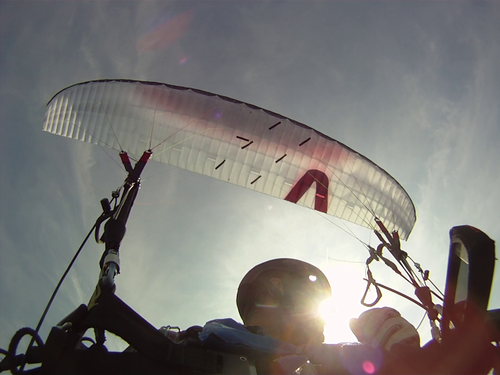Skywalk Chili2 M |
|||||||||||||||||||||||||||||||||||||||||||||||||||||||||||||||||||||||||||||||||||||||||||||||||||||||||||||||||||||||||||||||


|
|||||||||||||||||||||||||||||||||||||||||||||||||||||||||||||||||||||||||||||||||||||||||||||||||||||||||||||||||||||||||||||||
Instability rating |
|||||||||||||||||||||||||||||||||||||||||||||||||||||||||||||||||||||||||||||||||||||||||||||||||||||||||||||||||||||||||||||||
|
|||||||||||||||||||||||||||||||||||||||||||||||||||||||||||||||||||||||||||||||||||||||||||||||||||||||||||||||||||||||||||||||
Glider characteristics |
|||||||||||||||||||||||||||||||||||||||||||||||||||||||||||||||||||||||||||||||||||||||||||||||||||||||||||||||||||||||||||||||
|
Launch preparations: difficult
launch characteristics: dynamic, climbs constantly, no guidance necessary, good feedback during inflation, moderate braking required, control check simple, low takeoff speed
asymmetric collapse: canopy collapses at low angle to leading edge, moderate dynamics, total course change 90-180°, (1), moderate course change rate, moderate forward pitching 45-60°, (2), moderate height loss 30-39 m, (2), moderate sink velocity 15-19 m/s, (2), with tendency to cravat, (4), G-Force < 2,5 G, (1)
Frontal collapse: moderate pitch backwards 30-45°, moderate pitch forwards 30-45°, moderate dynamics, no course change, (1), delayed recovery, usually symmetric recovery, delayed return to normal airspeed, delayed reinflation of wingtips, with tendency to cravat, (4), moderate height loss 30-39 m, (2), low sink velocity 10-14 m/s, (1)
Spiral dives: moderate sink velocity increase, Moderate G-Force 3,5- 4.0 G, (2), Sink velocity after 720° <14 m/s, (1), Moderate maximum sink velocity < 18 m/s, (2), sink velocity increase < 6 m/s on brake release, (2), Course change 180-360° after spiral exit, (2), moderate height loss during recovery 30-60 m, (2)
B-Stall: normal force required, marked pitch backwards 30-45°, marked pitch forwards 30-45°, stable sink phase, no tendency to deform, 6-8 m/s, height loss on recovery < 20 m
big ears: simple initiation, stable flight phase, delayed automatic recovery, Vsink unaccelerated 2,5-3 m/s, Vsink accelerated 3,5-4 m/s, Vunaccelerated 3-5 km/h less than trimspeed, Vaccelerated >8 km/h faster than trimspeed |
|||||||||||||||||||||||||||||||||||||||||||||||||||||||||||||||||||||||||||||||||||||||||||||||||||||||||||||||||||||||||||||||
Notes |
|||||||||||||||||||||||||||||||||||||||||||||||||||||||||||||||||||||||||||||||||||||||||||||||||||||||||||||||||||||||||||||||
|
Launch characteristics: Gliders which climb rapidly and need a good block on the brakes to prevent them from overshooting require mode advanced coordinative skills to launch safely. This was the case with Ozone's Rush 3; particularly at steep launch sites, good reactions are required to keep the canopy under control at all times. The Nova Mentor 2, Skywalk Chili 2 and Golden 3 from Gradient were all somewhat tamer, but giving these gliders too much of an impulse or leaving your hands on the A-risers for a little too long would make them all clearly overshoot. Asymmetric Collapse: Under the LTF-B gliders the differences were, as expected, greater. Low-end gliders Paratech P28 and Swing Arcus 6 were almost identical to the LTF A models. Others were somewhat more dynamic, but all within acceptable limits. Under the high-end LTF-B gliders things are different: the bandwidth here, of possible reactions to a collapse is much greater. All gliders demonstrated reactions applicable to the test norm for some collapses, but could also react far more dynamically on occasion. The Skywalk Chili 2 collapses particularly softly and unremarkably. On recovery the outer part of the collapsed wing inflates first, which occasionally lead to a cravat. The Nova Mentor generally reacts very well to collapses of all sizes, but again can react particularly dynamically on occasion. Large collapses, on the outer limit of the norm measurement field can lead to cravats, and require active recovery from the pilot to prevent entering a spiral dive. Cravats, generally the “worst case scenario” for hobby pilots occurred on Ozone's Rush 3 when collapsed massively. This glider passed the LTF tests with folding lines attached to the front of the canopy, and reacts more dynamically to collapses induced via the A-risers. We note here critically, that folding lines are not necessary to collapse the glider according to the LTF-norm. The Niviuk Hook 2 was particularly dynamic, with fast rotations, high sink velocities and large height losses of approximately 70m after collapsing. Some of the gliders found in the high-end B sector clearly have the potential to expect too much from a hobby pilot. It is evident that the line between “appropriate behavior according to the norm” and “not certifiable” is very thin in some instances. Frontal Collapses: From accident investigations we know there are two main problems when dealing with frontal collapses: if a glider recovers very slowly, often combined with collapsed ears then should the pilot apply brake at the wrong moment, this can lead to a full stall. If pilots attempt to open the collapsed ears by applying symmetric brake before the glider has regained sufficient airspeed, then this may result in a full stall with all its consequences and height loss. For such gliders it is particularly important to adhere to the approved school of thought: “hands up” until the glider has regained normal airspeed. Another problem which is becoming more evident with the popularity of higher aspect ratio gliders, is the tendency of a canopy to deform in the middle “horseshoe” after a frontal collapse. Re-inflation often occurs asymmetrically, and the collapsed part of the canopy may then hang in the lines or cravat. It is often not possible to stop the following rotation without resorting to a stall. These characteristics are nothing new, but are often not revealed though the LTF norm tests, especially when the tests are conducted at the minimum folding limit. Advanced pilot skills are required to deal with such situations: a short jab on the brakes is required at the right moment to prevent the glider entering a horseshoe. Woe is in store for the pilot who stays on the brakes for too long – the canopy is prevented from regaining airspeed and can directly enter a full stall. In our tests the Niviuk Hook 2 demonstrated a tendency to horseshoe, combined with fast rotation speeds and a danger of twisting. “Normal-speed symmetric recovery” from a massive frontal collapse as demonstrated by e.g. Nova Ion Light and Prion, Skywalk Mescal 3 and Gradient 4, are the least challenging for the hobby-pilot. A significantly delayed recovery, or the tendency to horseshoe require much better pilot skills to manage safely, and are always associated with greater loss of height. |
|||||||||||||||||||||||||||||||||||||||||||||||||||||||||||||||||||||||||||||||||||||||||||||||||||||||||||||||||||||||||||||||
Rating |
|||||||||||||||||||||||||||||||||||||||||||||||||||||||||||||||||||||||||||||||||||||||||||||||||||||||||||||||||||||||||||||||
|
Safety class 4 This class of paraglider reacts demandingly to one or more of the following manoeuvres: frontal collapse, asymmetric collapse or spiral dive.Demandingly means that the above manoeuvres result in marked dynamic reactions from the glider and/or large height losses. Advanced piloting skills which need to be regularly practised, together with good personal reaction times are required to safely fly this class of gliders. Basic recovery techniques for ending a manoeuvre are not sufficient to maintain control, reduce height loss to a minimum and prevent subsequent critical reactions. Pilots should be able to recognise the onset of the above manoeuvres and be able to prevent or minimise their effects through immediate and precise pilot inputs. Additional experience such as regular ground handling and SIV training is required to safely fly gliders of this class. Special training or pilot skills which exceed standard training may be required for the safe performance of emergency descent techniques. Gliders of this Safety Class are not suitable for beginners, irregular flyers or low-airtime pilots. |
|||||||||||||||||||||||||||||||||||||||||||||||||||||||||||||||||||||||||||||||||||||||||||||||||||||||||||||||||||||||||||||||

